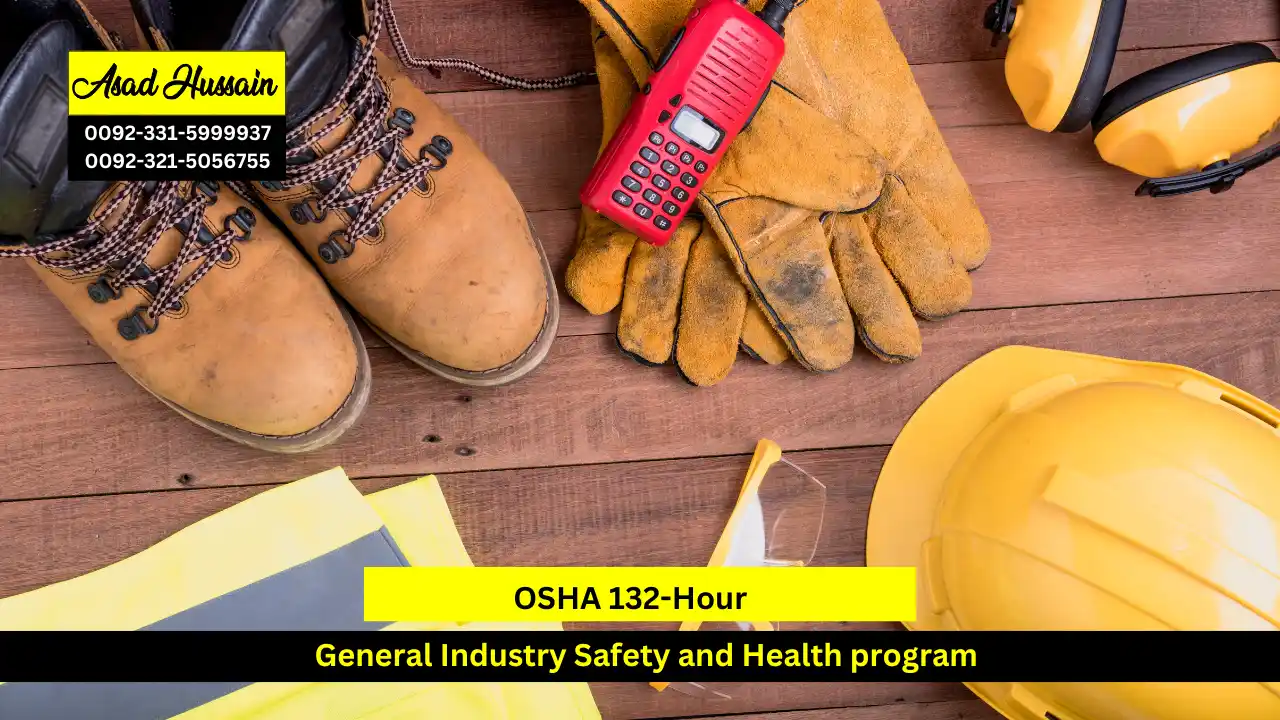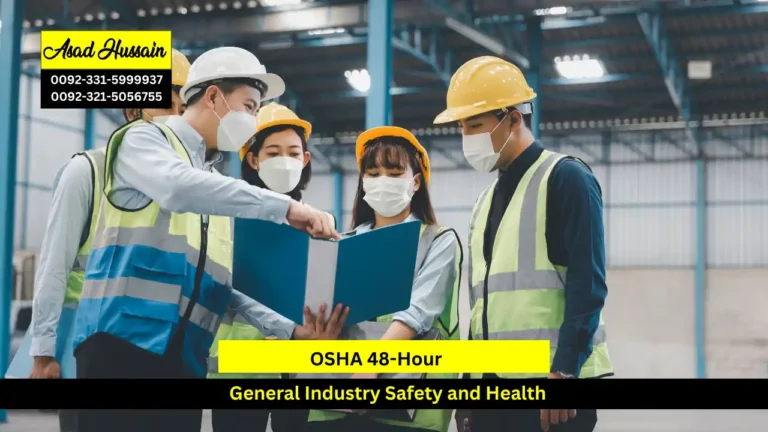In today’s fast-paced work environments, ensuring the safety and health of employees is more crucial than ever. The OSHA 132-Hour General Industry Safety and Health program stands as a vital resource for professionals dedicated to creating safer workplaces across various industries. This comprehensive training program is designed to equip safety professionals, managers, and employees with the knowledge and skills needed to effectively identify, assess, and manage workplace hazards.
The OSHA 132-Hour General Industry Safety and Health program provides an in-depth exploration of occupational safety and health standards. Administered by the Occupational Safety and Health Administration (OSHA), this program covers a broad range of topics essential for maintaining safety in general industry settings. It’s tailored to address common hazards found in manufacturing, warehousing, distribution, and service industries, among others.
Investing in the OSHA 132-Hour General Industry Safety and Health program is a proactive step towards building a safer, more compliant workplace. By providing comprehensive training on a wide range of safety topics, this program empowers professionals to create effective safety strategies, manage risks, and ensure the well-being of employees. As workplace safety continues to be a priority, programs like this play a crucial role in fostering a culture of health and safety that benefits everyone.
Program Highlights
Mandatory Units
- Introduction to OSHA and General Industry Safety
- Walking and Working Surfaces
- Electrical Safety Standards
- Hazard Communication
- Personal Protective Equipment (PPE)
- Fire Safety and Prevention
- Machine Guarding and Lockout/Tagout
- Ergonomics
- Hazardous Materials and Waste Management
- Industrial Hygiene and Occupational Health
- Confined Spaces
- Emergency Response and Preparedness
- Accident Investigation and Recordkeeping
- Health and Safety Management Systems
- Safety and Health Training Techniques
- Special Topics and Emerging Issues
Basic Educational Background
- Minimum Education: A high school diploma or equivalent (such as a GED) is typically required. This ensures that participants have the foundational academic skills needed to understand complex safety concepts and regulations.
Professional Experience
- Relevant Work Experience: While not always mandatory, having prior work experience in a general industry setting is highly beneficial. Experience in roles related to safety, health, or operations can provide practical context and enhance comprehension of the course material.
Understanding of Workplace Safety
- Basic Safety Knowledge: Familiarity with basic safety concepts and procedures can be advantageous. Some courses may provide introductory materials or assume that participants have a foundational understanding of workplace safety principles.
Commitment to Course Duration
- Time Commitment: The course spans 132 hours, which is usually divided over several weeks or months. Participants should be prepared to commit to the full duration of the course, including attending all scheduled classes and completing any required assignments or projects.
5. Technical Requirements
- Access to Technology: For online or hybrid courses, participants need access to a reliable computer and the internet. Familiarity with online learning platforms and basic computer skills are essential for navigating course materials and participating in virtual discussions.
English Proficiency
- Language Skills: Since course materials and instruction are typically provided in English, participants should have a good command of the English language. This includes reading, writing, and comprehension skills sufficient to understand technical safety content and participate in discussions.
Registration and Fees
- Enrollment: Participants must complete the registration process, which may include submitting personal information, payment of course fees, and possibly providing proof of eligibility or background information.
Pre-Course Preparation
- Pre-Reading and Materials: Some programs may require participants to review pre-course materials or complete preliminary reading assignments before starting the course. Checking with the training provider for any preparatory requirements is recommended.
Health and Safety Certifications (Optional)
- Previous Certifications: While not always required, having prior certifications such as OSHA 10-Hour or 30-Hour General Industry training can be beneficial. These certifications may provide a helpful foundation for the more advanced topics covered in the 132-hour course.
Introduction to OSHA and General Industry Safety
- Understand OSHA’s role and functions: Explain OSHA’s mission, purpose, and the regulatory framework governing workplace safety.
- Identify OSHA standards and regulations: Describe key OSHA standards relevant to general industry and their application.
- Recognize the importance of compliance: Assess the impact of OSHA regulations on workplace safety and the consequences of non-compliance.
Walking and Working Surfaces
- Identify common hazards: Recognize hazards associated with walking and working surfaces, including slips, trips, and falls.
- Implement control measures: Develop and apply strategies to prevent and mitigate walking and working surface hazards.
- Conduct inspections: Perform inspections to identify potential hazards and ensure compliance with safety standards.
Electrical Safety Standards
- Understand electrical hazards: Identify common electrical hazards in the workplace and their potential risks.
- Apply safety standards: Apply OSHA electrical safety standards to prevent electrical accidents and injuries.
- Use proper safety equipment: Select and utilize appropriate personal protective equipment (PPE) for electrical work.
Hazard Communication
- Comprehend hazard communication requirements: Explain the purpose and components of OSHA’s Hazard Communication Standard (HCS).
- Utilize Safety Data Sheets (SDS): Interpret and use SDS to understand chemical hazards and safety measures.
- Implement communication strategies: Develop and implement effective hazard communication plans in the workplace.
Personal Protective Equipment (PPE)
- Identify PPE requirements: Determine the appropriate PPE needed for various workplace hazards.
- Ensure proper use and maintenance: Demonstrate correct use, care, and maintenance of PPE.
- Conduct PPE training: Train employees on the selection, use, and maintenance of PPE.
Fire Safety and Prevention
- Recognize fire hazards: Identify common fire hazards in the workplace and their causes.
- Implement fire prevention measures: Develop and apply strategies to prevent fires and minimize fire risks.
- Develop emergency procedures: Create and implement fire safety plans, including evacuation procedures and emergency response.
Machine Guarding and Lockout/Tagout
- Understand machine guarding requirements: Explain the importance of machine guarding and the types of guards used.
- Implement lockout/tagout procedures: Apply lockout/tagout procedures to control hazardous energy and prevent accidental machine start-up.
- Conduct safety audits: Perform audits to ensure compliance with machine guarding and lockout/tagout standards.
Ergonomics
- Identify ergonomic hazards: Recognize common ergonomic hazards and their impact on health and productivity.
- Implement ergonomic solutions: Develop and apply ergonomic practices to reduce the risk of musculoskeletal disorders.
- Conduct ergonomic assessments: Perform ergonomic assessments and recommend improvements to workstations and tasks.
Hazardous Materials and Waste Management
- Understand hazardous materials regulations: Explain the regulations and standards for managing hazardous materials and waste.
- Implement safe handling procedures: Develop and apply procedures for the safe handling, storage, and disposal of hazardous materials.
- Conduct spill response: Prepare and execute response plans for hazardous material spills and incidents.
Industrial Hygiene and Occupational Health
- Identify industrial hygiene principles: Explain the principles of industrial hygiene and their application in assessing workplace health hazards.
- Conduct health risk assessments: Perform assessments to identify and evaluate potential occupational health risks.
- Implement control measures: Develop and apply control measures to mitigate health risks and improve workplace conditions.
Confined Spaces
- Recognize confined space hazards: Identify the hazards associated with confined spaces and the requirements for safe entry.
- Implement confined space entry procedures: Develop and apply procedures for safe confined space entry and work.
- Conduct confined space training: Train employees on confined space safety practices and emergency procedures.
Emergency Response and Preparedness
- Develop emergency response plans: Create comprehensive emergency response plans tailored to specific workplace scenarios.
- Implement preparedness measures: Develop and implement preparedness measures to respond effectively to emergencies.
- Conduct drills and training: Organize and conduct emergency drills and training to ensure readiness and compliance.
Accident Investigation and Recordkeeping
- Conduct accident investigations: Perform investigations to determine the causes of workplace accidents and incidents.
- Develop corrective actions: Recommend and implement corrective actions to prevent recurrence of accidents.
- Maintain records: Maintain accurate and complete records of accidents, incidents, and safety activities in accordance with OSHA requirements.
Health and Safety Management Systems
- Understand management systems: Explain the components and benefits of health and safety management systems (HSMS).
- Implement HSMS: Develop and implement HSMS to enhance workplace safety and health.
- Monitor and review: Monitor and review the effectiveness of HSMS and make improvements as needed.
Safety and Health Training Techniques
- Design effective training programs: Develop and deliver safety and health training programs that meet OSHA standards and address specific workplace needs.
- Engage learners: Use effective training techniques to engage participants and enhance learning outcomes.
- Evaluate training effectiveness: Assess the effectiveness of training programs and make necessary adjustments to improve results.
Special Topics and Emerging Issues
- Identify emerging safety issues: Stay informed about new and emerging safety issues and trends in the industry.
- Implement best practices: Apply best practices and innovative solutions to address special topics and emerging issues.
- Adapt to changes: Adapt safety strategies and practices in response to evolving workplace conditions and regulatory changes.
The OSHA 132-Hour General Industry Safety and Health course is designed for safety professionals, managers, and employees who are committed to enhancing workplace safety and health standards. This course is ideal for safety managers and coordinators responsible for developing and overseeing safety programs, compliance officers who ensure adherence to OSHA regulations, and human resource professionals involved in safety training and employee wellness initiatives. Additionally, frontline supervisors and employees who seek to deepen their understanding of safety practices and hazard management will benefit from the comprehensive training provided. By equipping participants with extensive knowledge and practical skills, this course is tailored to anyone looking to contribute to a safer and more compliant work environment across various general industry sectors.





